Homemade bibimbap is so delicious I could have it every single day! Loaded with seasoned vegetables, a creamy yolk and a fiery gochujang sauce, it’s the perfect midweek meal to give my body a boost of energy! This version is meat-free and is topped with crispy tofu instead. Super delish!
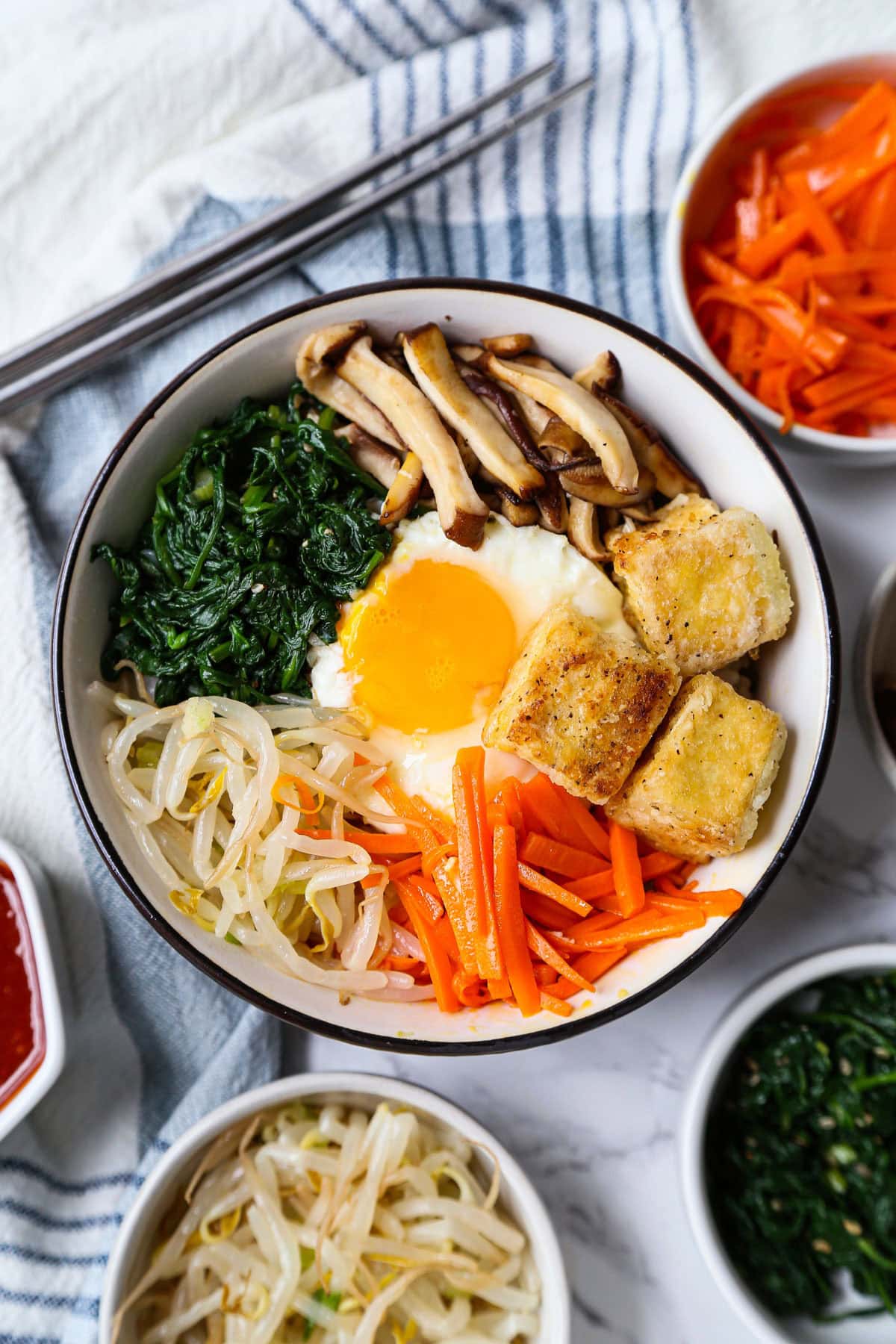
Korean cooking is never boring, it’s a cuisine that knows how to pile on the flavors for maximum belly happiness.
A classic bowl of bibimbap is a great example of what the cuisine excels at – it’s colorful, tasty, often spicy, and layered with so many tasty ingredients it makes cooking Korean food look complicated.
The recipe I have for you offers the classic vegetable toppings found in most bibimbap – spinach, beans sprouts, shiitake mushrooms, and carrots. The only difference is that my rice bowl is missing the popular bulgogi-style beef and comes with crispy tofu instead. Remember how I said I’ve quit eating meat? Well, it’s been over two years now and I don’t miss it one bit!
Table of contents
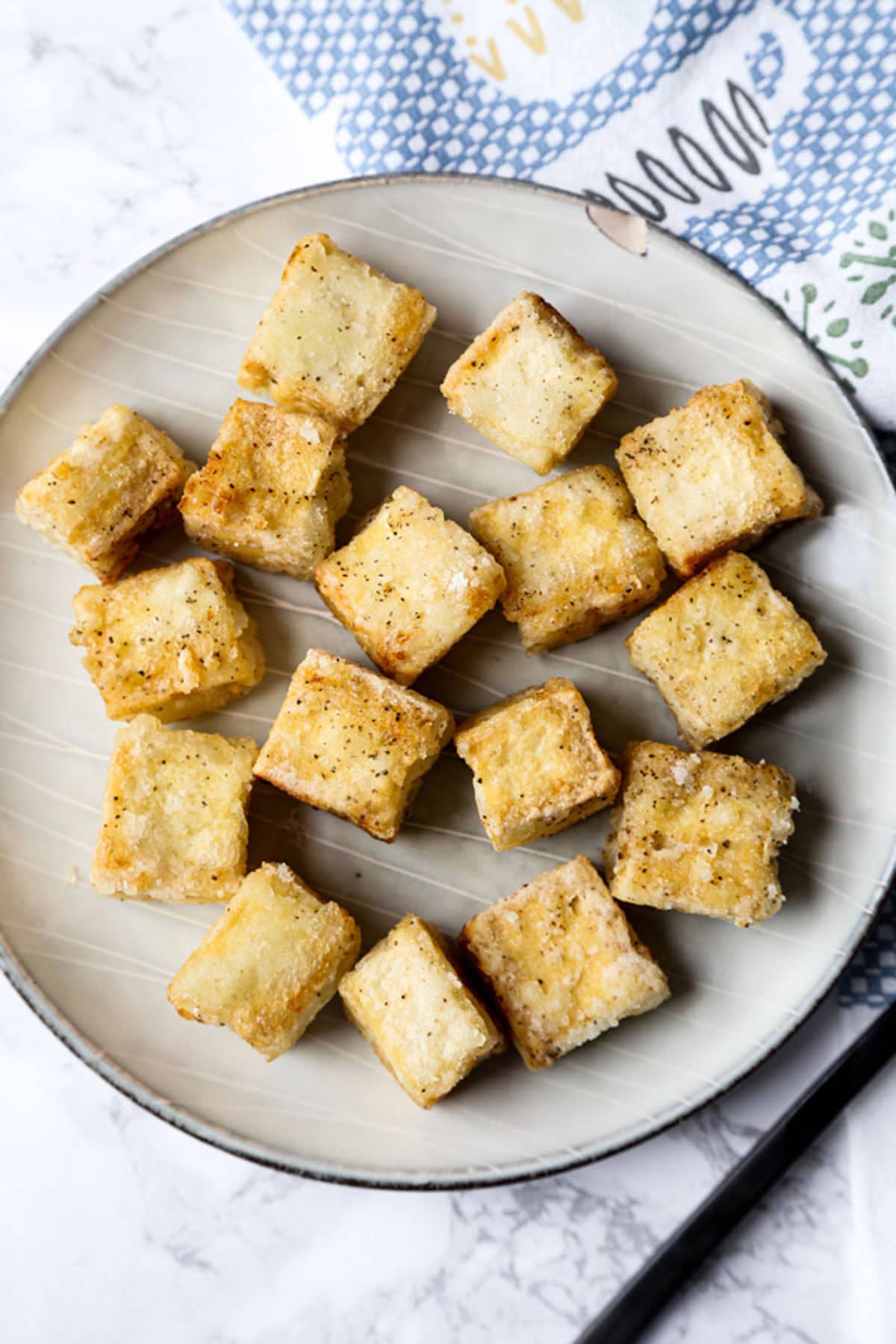
What is Bibimbap?
Bibimbap (비빔밥) is a popular Korean dish of warm rice served in a bowl and topped with namul (sauteed and seasoned vegetables), gochujang (Korean red chili paste), soy sauce, a fried or raw egg, meats, seafood, or tofu. The colorful ingredients are placed next to each other to make the dish visually appealing, with the egg added in the center.
The word bibim means a mixture of various ingredients while the word bap means rice. The literal translation for bibimpab – mixed rice.
What Type of Rice to Use
To make bibimbap, always use short grain rice for its sticky texture and ability to absorb flavors really well. I use Tamanishiki short grain rice for both Japanese and Korean cooking. You can also use short grain brown rice (genmai) for a healthier and more nutritious meal.
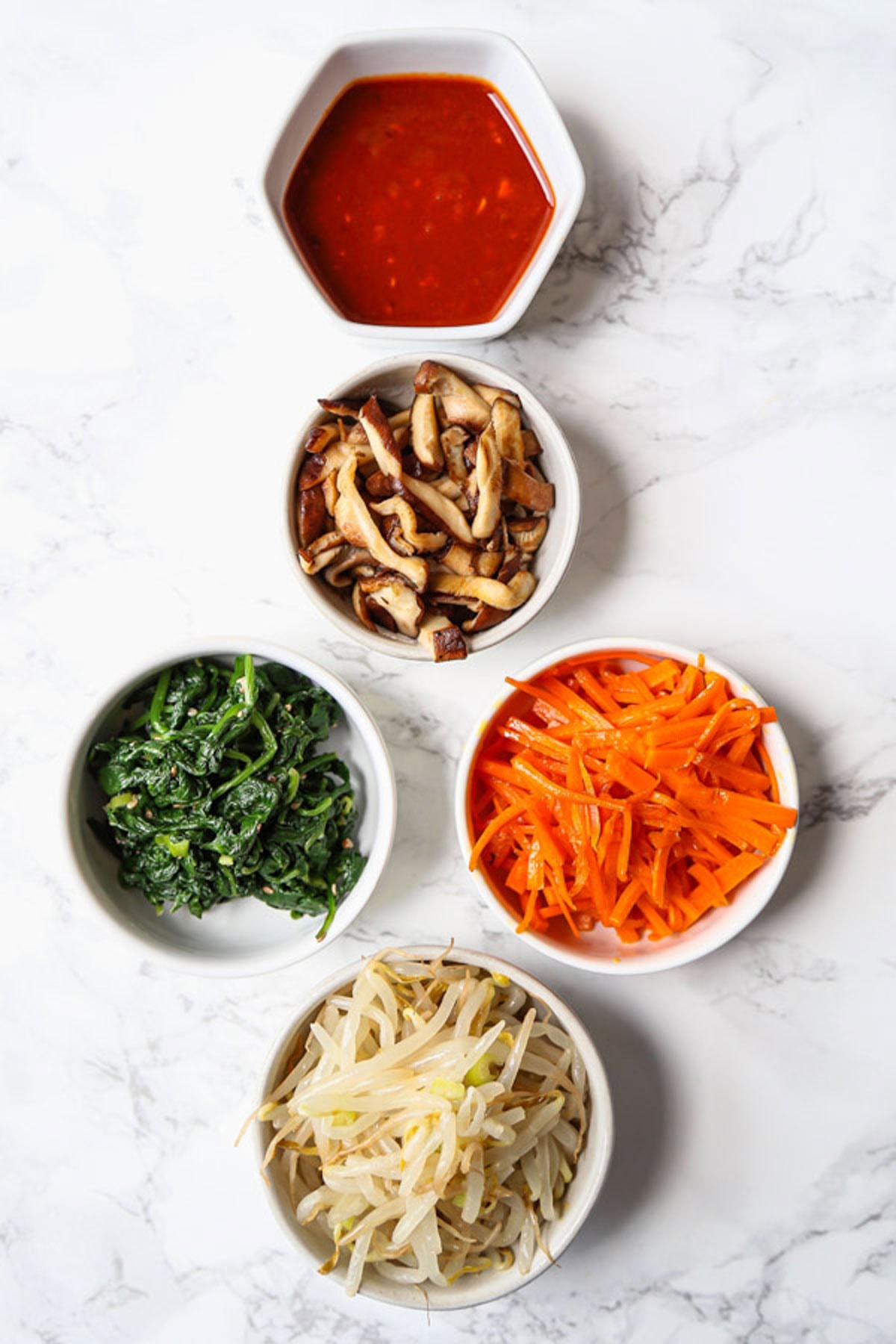
Ingredients For Bibimbap
- Tofu: Medium firm or firm texture works. I prefer medium firm as it retains more moisture and gives the cubes a lighter, silkier texture.
- Cornstarch: To dust the tofu cubes and give them a crispy exterior. You can also use potato starch.
- Oil: Only 2-3 tablespoons is needed to pan fry the tofu cubes. Use a neutral oil such as vegetable or grapeseed.
- Carrot: A small carrot is enough for two bowls, or you can use 4-6 baby carrots.
- Beans sprouts: I used beans sprouts but if you want to stick to the real deal, visit your local Asian supermarket to hunt for some mung beans.
- Shiitake mushrooms: The strong earthy flavor of shiitake mushrooms elevate this dish. If you cannot find shiitake mushrooms, use straw mushrooms which are sold in cans.
- Baby spinach: You can use regular spinach instead of baby spinach but if you do, give it a good chopping.
- Toasted sesame oil: Toasted sesame oil is used to add nuttiness to the vegetables.
- Garlic: Used to season the vegetables by adding sweetness and a slightly pungent note.
- Scallions: Make sure to finely chop the scallions as they will be used as a flavoring agent for the vegetables and add a slight crunch. The finer the chop, the better!
- Sesame seeds: Use white or black sesame seeds to impart nuttiness.
- Rice: Use short grain white or brown rice.
- Egg: You can fry it or serve it raw. As long as the yolk remains creamy it will be delicious!
- Bibimbap sauce: My bibimbap sauce recipe is a mixture of gochujang (Korean red chili paste), sesame oil, rice vinegar, honey, sugar, water, and garlic.
Topping Variations
You don’t have to stick to this specific recipe to make bibimbap, there are so many different and fun ways to serve this dish! If your family prefers bell peppers over carrots, switch them up! I’ve even topped my rice with chickpeas once and it was still yummy!
Here are a few ideas on how you can be creative with your Korean rice bowl:
- Use chopped kale or shredded cabbage (both cooked) instead of spinach.
- Use zucchini or snow peas as substitutes to carrots or beans sprouts.
- Top with fried wonton strips.
- Top with some cabbage or cucumber kimchi. Kimchi is so versatile that it can be used in multiple ways!
- Add another protein such as fish, chicken, or beef.
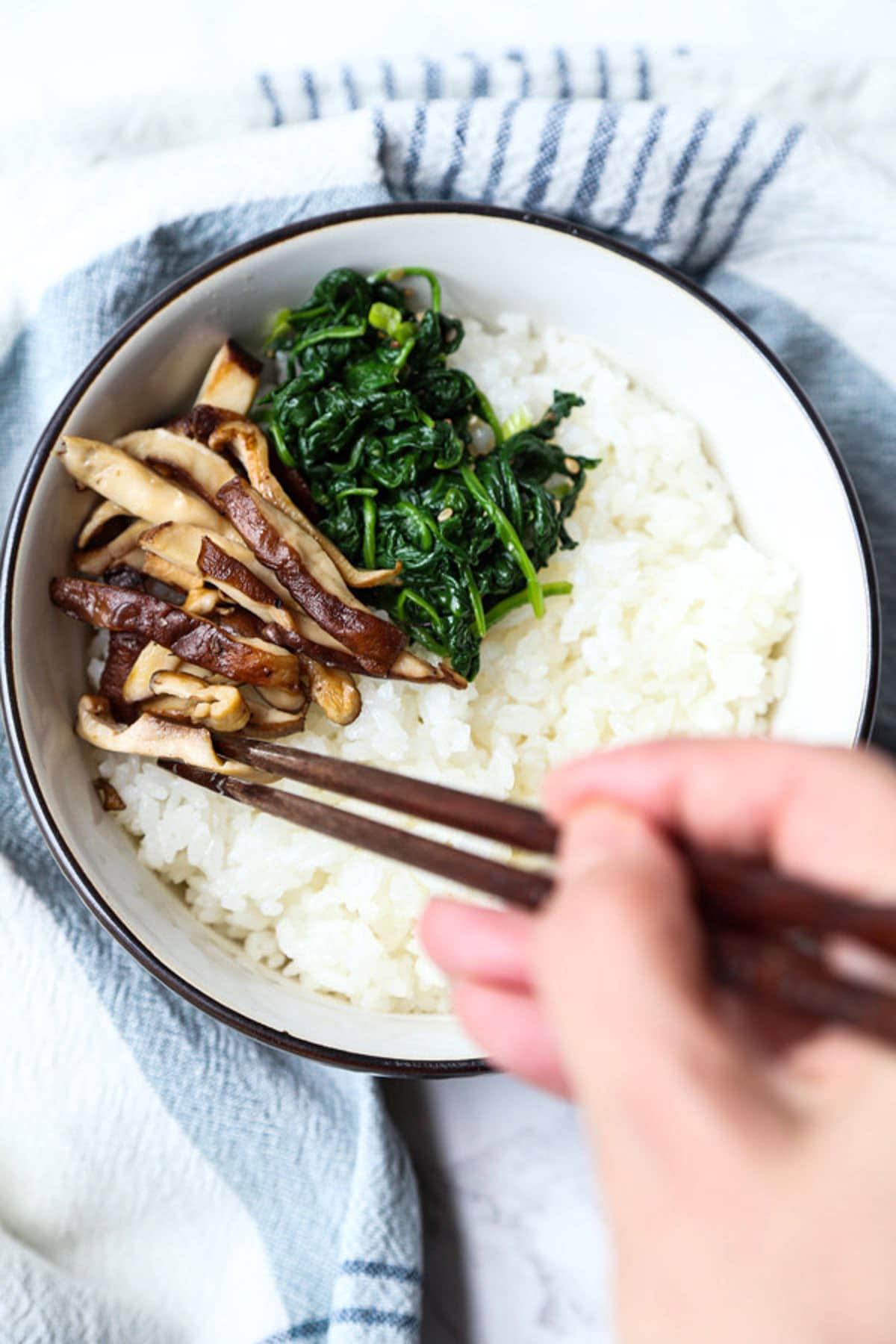
Dolsot Bibimbap vs Regular Bibimbap
I’m sure you’ve noticed that sometimes bibimbap shows up as dolsot bibimbap when looking for a recipe, and if you are like me you are wondering what the difference is and which one is better.
It turns out that there is no difference in the actual dish but in the cooking ware used to make the dish. The word dolsot means stone pot and it’s what is traditionally used to make bibimbap, soondubu, and other popular Korean dishes. The sizzling pots served at your favorite Korean restaurant? Yep, that’s a dolsot!
The reason why dolsot is the preferred choice for serving bibimbap is because the rice at the bottom of the dish gets super crispy and flavorful. If you don’t own a stone pot but would like to try something similar to the dolsot version, try making it in a skillet. I have a delicious and super easy skillet dolsot bibimbap recipe that yields a similar rice texture.
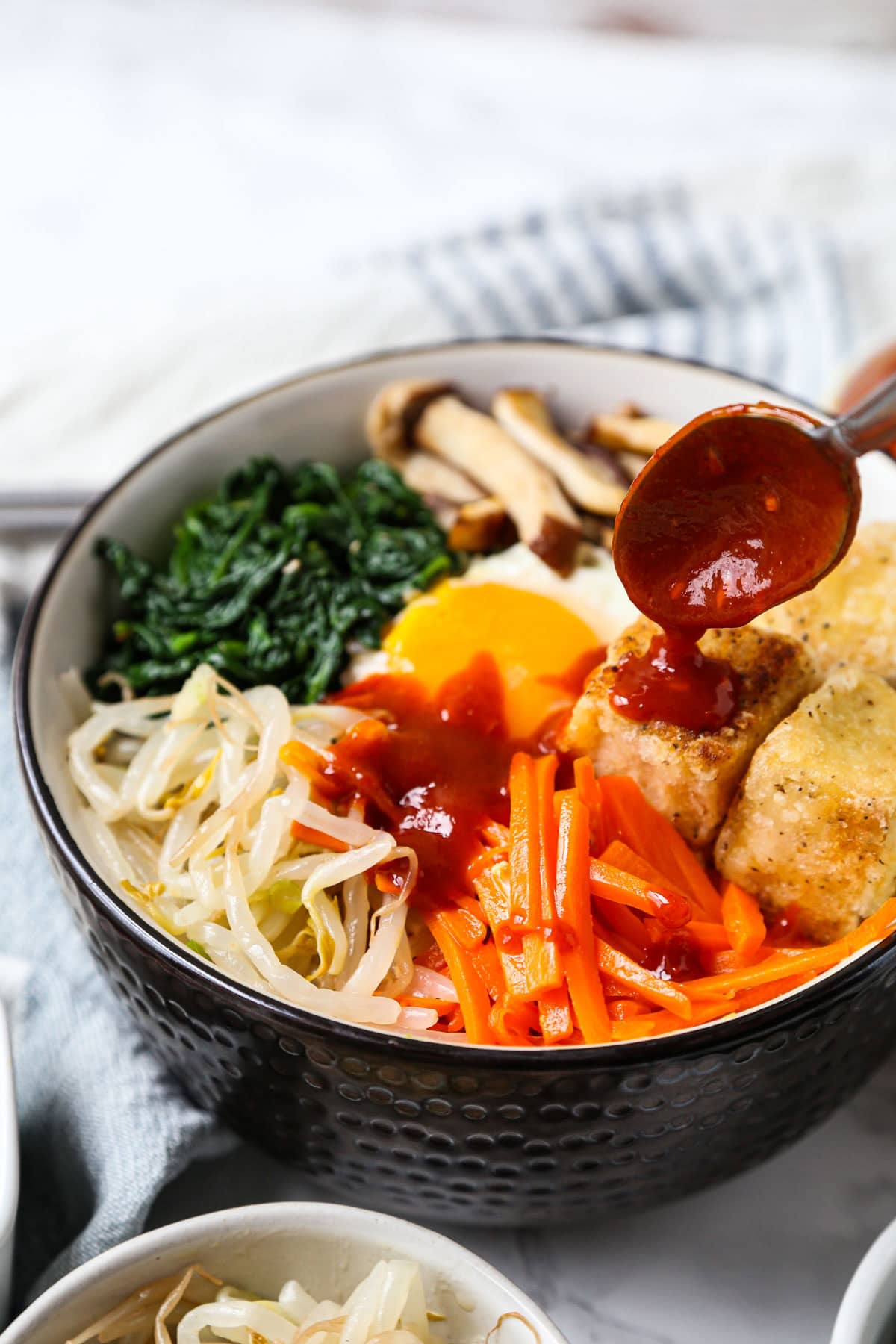
How To Make Bibimbap
- Make the bibimbap sauce and set aside.
- Drain and slice the tofu into cubes and dust all sides with cornstarch.
- Fry the tofu in a pan until the cubes are golden brown and drain them on paper towel.
- Briefly fry the carrots in a pan, transfer them to a bowl and do the same for the shiitake mushrooms. Season with a little salt.
- Blanch the spinach and shock in cold water. Drain, squeeze out excess water and toss the spinach in sesame oil, salt, and chopped scallions. Repeat the same steps for the beans sprouts.
- Divide two cups of warm cooked rice into two bowls and top with the ingredients and an egg in the center.
- Serve with bibimbap sauce. Enjoy!
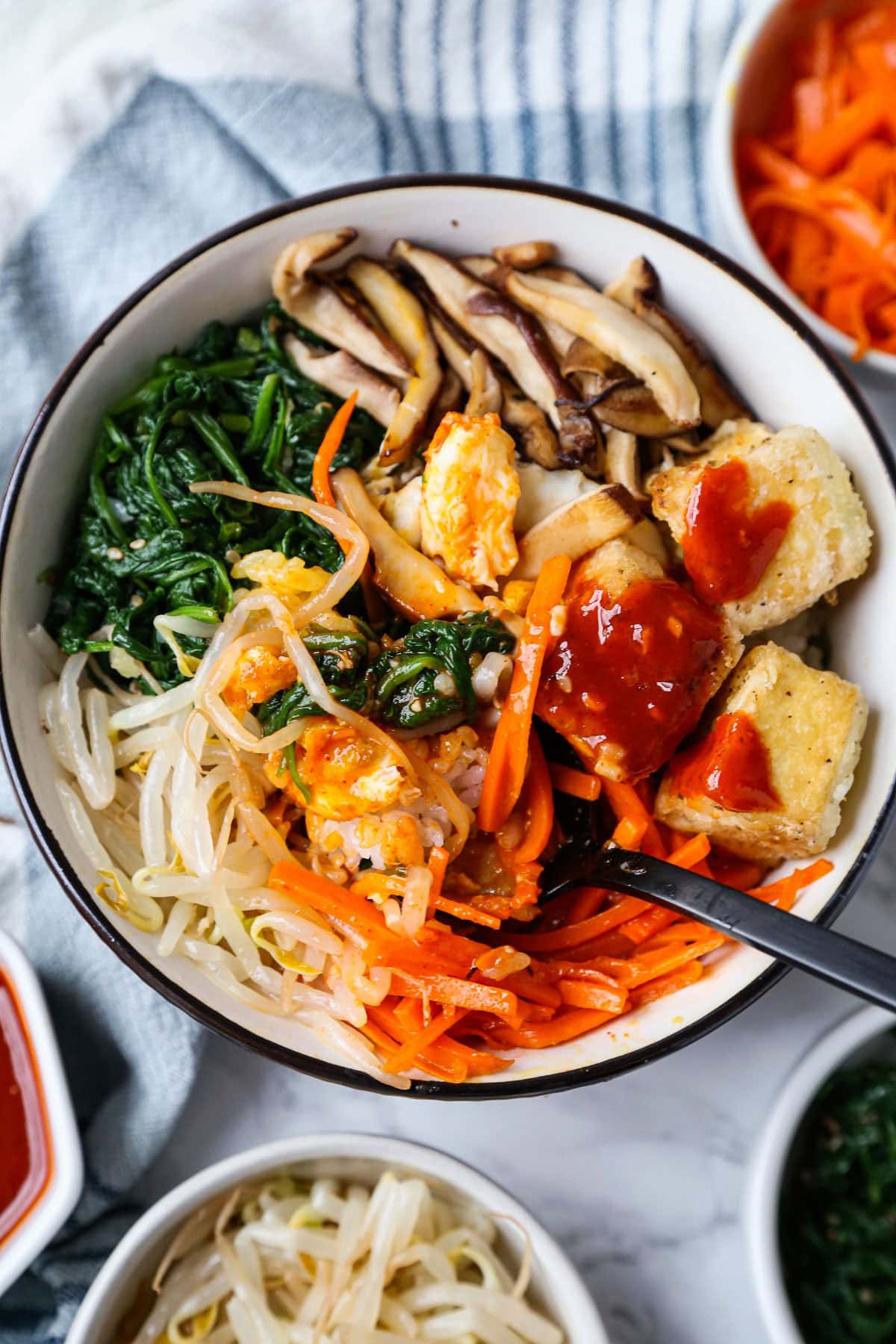
What to Serve with Bibimbap
I told you making bibimbap wasn’t that hard! There are quite a few ingredients to use but the actual cooking process is very quick and simple. And it’s so worth it because what you end up with is a vibrant, wholesome rice bowl packed with assertive flavors (salty, nutty, savory, spicy) that taste different with every bite you take!
Here are some of my favorite dishes to serve with this Korean classic:
- Dongchimi (Korean radish water kimchi)
- Korean spinach (sigeumchi namul)
- Homemade vegan kimchi
- Steamed Korean eggplant (gaji namul)
- Sweet Korean marinated eggs
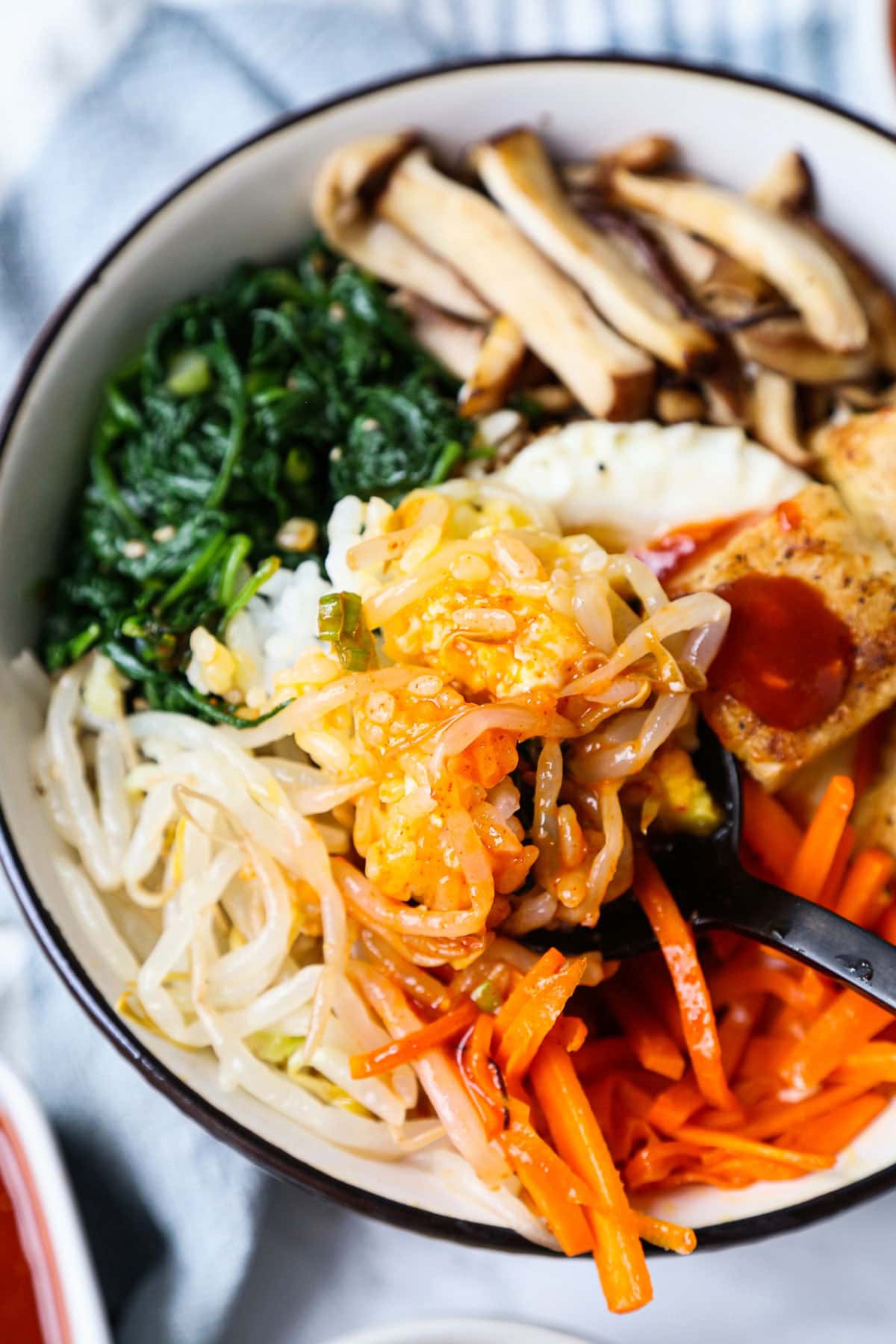
Other Korean Recipes You Might Like To Try
Did you like this recipe? Are there changes you made that you would like to share? Share your tips and recommendations in the comments section below!
Print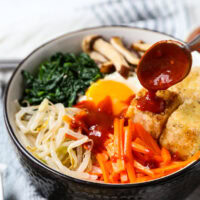
Easy Tofu Bibimbap – 비빔밥
- Prep Time: 20 minutes
- Cook Time: 15 minutes
- Total Time: 35 minutes
- Yield: 2 bowls 1x
- Category: Vegetarian
- Method: Mixing Bowl
- Cuisine: Korean
- Diet: Vegetarian
Description
Loaded with seasoned vegetables, a creamy yolk and a fiery gochujang sauce, bibimbap is the perfect midweek meal for a boost of energy! This version is meat-free.
Ingredients
- Bibimbap sauce
- 1/2 firm tofu block
- 2 tablespoons cornstarch
- 2 tablespoons + 1 teaspoon vegetable oil
- 1 small carrot, chopped into matchsticks
- 150g beans sprouts
- 4 shiitake mushrooms, chopped
- 150g baby spinach
- 2 tablespoons sesame oil
- 1 teaspoon minced garlic
- 2 teaspoons finely chopped scallions
- 1 teaspoon sesame seeds
- 2 cups cooked white rice (short or medium grain)
- 2 fried eggs (or raw egg yolk)
Instructions
- Make the bibimbap sauce: Make the bibimbap sauce and set aside.
- Drain the tofu: Drain tofu and leave on a plate for 10 minutes. Drain again and slice into 2-inch piece cubes. Dust with cornstarch making sure all side are covered and set aside.
- Cook the tofu: Heat a large pan over medium high heat and add 2 tablespoons vegetable oil. When the oil is hot, add tofu and cook on each side for 2-3 minutes until crispy and golden brown. Turn the heat off, transfer tofu to paper towel and set aside.
- Cook the carrots: In a medium pan over medium high heat, add the vegetable oil, carrots and a sprinkle of salt. Cook for 2 minutes until tender but still yielding a crunch. Transfer to a small bowl and set aside.
- Cook the mushrooms: Add the shiitake mushrooms to the same pan and cook for 2-3 minutes until they are golden brown. Transfer to a small bowl and set aside.
- Blanch the spinach: Bring a medium size pot of water with 1 tablespoon salt to boil. Add the spinach and cook for 1 minute. Drain and rinse spinach under cold water until the spinach is cold. Gentle squeeze the spinach to remove excess water.
- Season the spinach: Put the spinach in a bowl and add 1 tablespoon sesame oil, 1/2 teaspoon minced garlic, 1 teaspoon scallions, 1/2 teaspoon sesame seeds, a sprinkle of salt, and toss the spinach (I use chopsticks) until it’s evenly coated.
- Bean sprouts: Repeat the same steps for the spinach to make the beans sprouts.
- Assemble the bibimbap: Divide the rice among 2 serving bowls. Place the eggs in the center of each bowl and arrange the vegetables around it. Serve with bibimbap sauce on the side.
Notes
Kid Friendly Bibimbap Sauce:
- 1 tablespoon white miso paste
- 2 teaspoons soy sauce
- 1/2 tablespoon sesame oil
- 1/2 tablespoon rice vinegar
- 1 teaspoon sugar
- 1 tablespoon water
- 1 teaspoon sesame seeds
Combine all the ingredients and serve.
Nutrition
- Serving Size: 1 bowl
- Calories: 630
- Sugar: 13g
- Sodium: 530mg
- Fat: 34g
- Saturated Fat: 10.4g
- Unsaturated Fat: 10.6g
- Trans Fat: 0g
- Carbohydrates: 68.9g
- Fiber: 5.5g
- Protein: 16.2g
- Cholesterol: 186mg
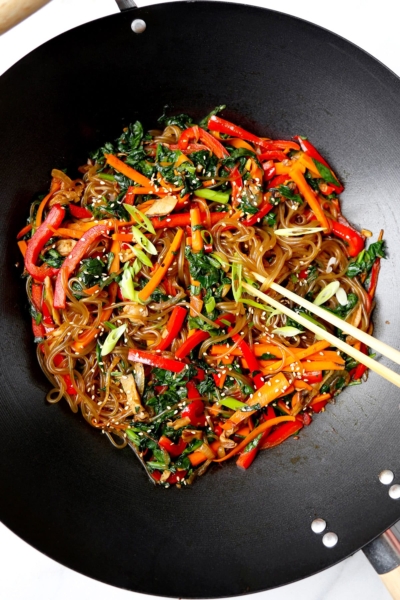
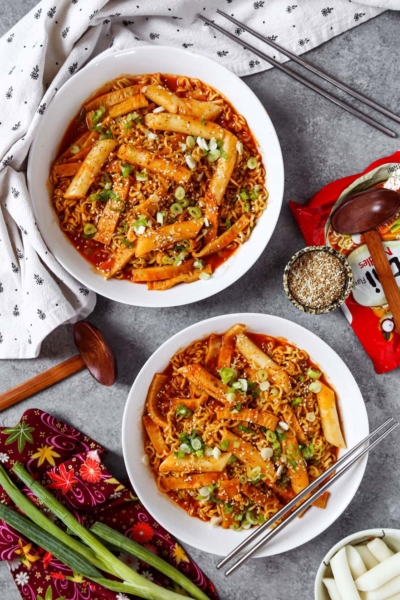

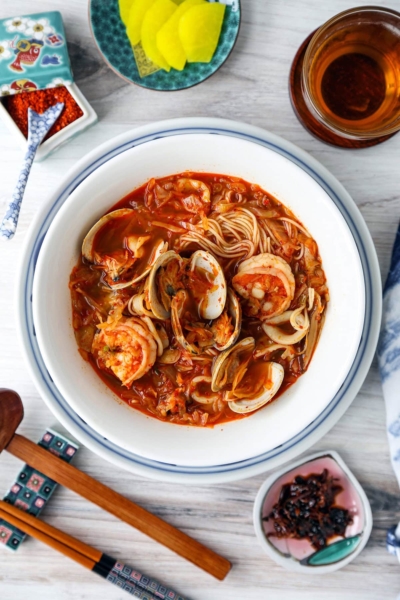















Questions and Reviews
I’ve never made bibimbap at home because for some reason it always intimidated me. But I’m definitely going to have to try it now! This looks delicious